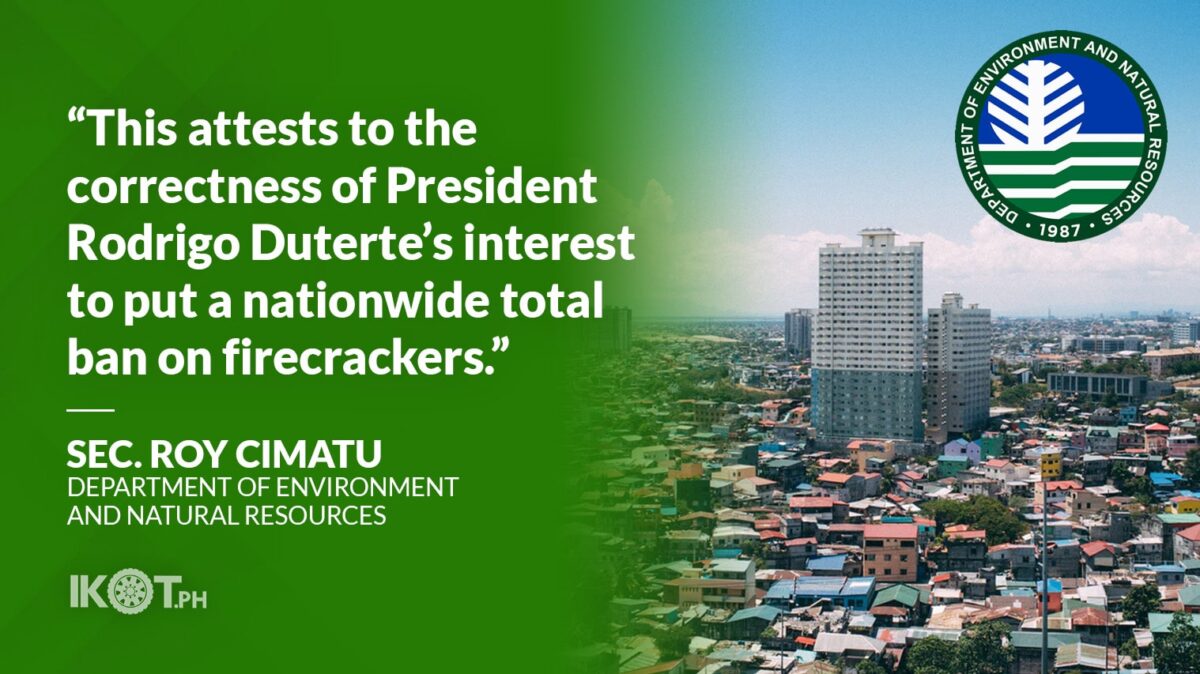The Department of Environment and Natural Resources (DENR) recorded a substantial reduction in air pollution levels on the first day of 2021 in Metro Manila by as much as 59 percent compared to pollution levels recorded last year.
DENR Secretary Roy Cimatu cited the support of Metro Manila local executives and residents to the government’s effective implementation of Executive Order 28 which limits the use of firecrackers to “community fireworks display” which has been in effect since 2017.
An average concentration of 87 micrograms per normal cubic meter (ug/Ncm) of Particulate Matter (PM 10) was obtained by DENR-Environmental Management based on the measured data between 12 midnight of Dec. 31, 2020 to Jan. 1, 2021 from its six air quality monitoring stations (AQMS) in Caloocan, Marikina, Navotas, Pasig, Parañaque and Taguig cities.
Last year, the six AQMS yielded an average of 213 ug/Ncm, thereby accounting for a 59-average percent drop compared to its New Year’s Eve (NYE) data on Jan. 1, 2020
“This attests to the correctness of President Rodrigo Duterte’s interest to put a nationwide total ban on firecrackers which I believe clearly speaks not only for the President’s strong policy agenda for health and safety, but for sound environmental governance as well,” Cimatu said.
The highest NYE percentage drop recorded is in Navotas with 99 percent.
The highest NYE percentage drop recorded are the stations in Naval Street in Navotas with 99 percent from 209 to 1.34 ug/Ncm; Oranbo, Pasig City, 95 percent (130 to 7 ug/Ncm); Bicutan, Taguig City, 78 percent (355 to 79 ug/Ncm); Marikina Justice Hall open compound, Marikina City, 34 percent (189 to 124 ug/Ncm); and Caloocan City Hall Annex, Caloocan City, 29 percent (332 to 235 ug/Ncm).
Only the station in Don Bosco Barangay Hall Compound, Parañaque showed a 21-percent increase from 62 to 75 ug/Ncm.
PM10 in firecrackers are mainly coming from residuals of the explosive powders wrapped in paper which consists of a mixture of sulfur (S), carbon (C), and potassium nitrate (saltpeter, KNO3) and other fine minerals that contain heavy metals. The short-term limit for PM10 is 150 ug/Ncm under the National Ambient Air Quality Guideline Value (NAAQGV) of Republic Act 8749 or the Clean Air Act.
Likewise, the EMB report noted that “the NYE 2021 have significantly lower concentrations of PM2.5 compared to the NYE 2020,” particularly for its station at the Muntinlupa Bilibid open ground in Muntinlupa City which posted a maximum concentration of 12 ug/Ncm between 12 midnight to 2 a.m. of Jan. 1, 2021. The reading accounts for a 43-percent drop from 22 ug/Ncm obtained for the same period in last year.
The report, however, noted its Manila City Station measured a high of 93.5 ug/Ncm around 1 a.m. of Jan. 1, 2021, from a reading of 40.9 ug/Ncm at 11 p.m. of Dec. 31, 2020. The short-term limit for PM2.5 is 35 ug/Ncm under the NAAQGV of DENR Administrative Order 2020-14 dated Oct. 21, 2020.
These are attributed to the strict measures being implemented by Metro Manila Mayors prohibiting individual and household use of firecrackers.
These are attributed to “the strict measures being implemented” by Metro Manila Mayors under Metro Manila Development Authority Resolution No. 20-17 “Prohibiting Individual and Household Use of Firecrackers and Other Pyrotechnic Devices During General Community Quarantine”.
Compared to PM10, PM2.5 pollutants are finer particles usually emitted by vehicles and burning plants.
These particles can reach the lungs when inhaled, leading to respiratory and circulatory diseases, including brain damage and cancer.

